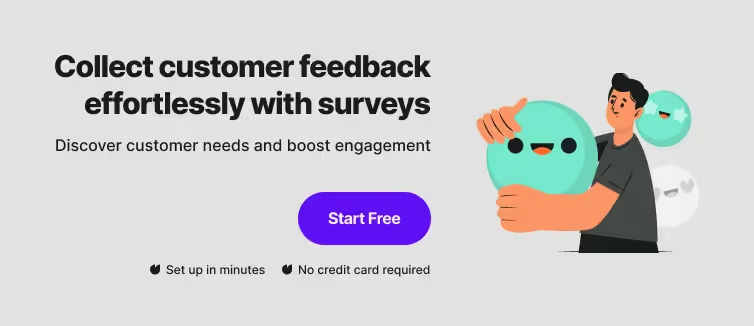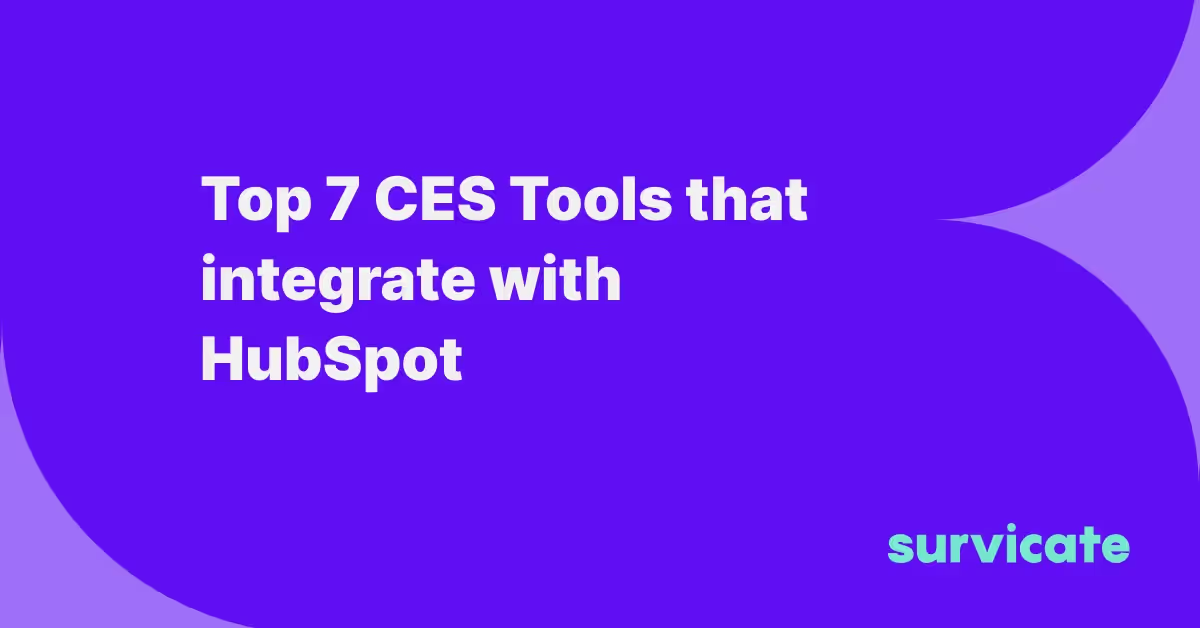Key Takeaways:
- Enterprise Feedback Management (EFM) is vital for large companies to gather and analyze customer feedback to improve experiences and operations.
- Choosing the right EFM software is crucial. It should be flexible, scalable, and integrate well with current systems.
- Centralize your data collection to have all customer feedback in one accessible place.
- Turn feedback into actionable insights with analytical tools, and make sure to act on the feedback to continuously improve.
- Segment your audience for targeted survey distribution, ensuring more relevant and higher quality feedback.
- Establish a closed-loop process to address customer feedback and communicate actions taken back to the customers.
- Use multi-channel feedback collection to get a well-rounded view of customer sentiment and integrate this feedback into your business processes for a proactive approach to customer satisfaction.
- Select EFM software with an enterprise plan that offers comprehensive features and ensure it can integrate seamlessly with your existing software for a unified customer feedback strategy.

Are you tired of guessing what your customers want? If you're steering a big ship in the business sea, it's time to drop the guesswork anchor.
Enterprise Feedback Management (EFM) is your compass for navigating customer waters in 2025. This article is a must-read for decision-makers in large organizations who are struggling to keep up with customer expectations. We'll dive into why EFM is not just a fancy business term but a critical tool for your company's success. By the end, you'll know how to turn customer whispers into strategic shouts that drive your business forward.
So, if you're ready to make every piece of feedback count, let's set sail!
Overview of Enterprise Feedback Management
Enterprise Feedback Management (EFM) is a comprehensive approach utilized by organizations to collect, analyze, and act on customer feedback. Primarily involving enterprise-level companies, EFM encompasses all aspects of gathering and managing customer insights to enhance business processes and customer satisfaction.
Why Enterprise Feedback Management is Essential
The theoretical underpinnings of enterprise feedback management rest on the belief that customer feedback is integral to organizational growth. It provides invaluable insights into customer preferences, behaviors, and expectations. When effectively managed, this feedback can lead to improved customer experiences, product enhancements, and operational excellence. Additionally, an EFM solution enables companies to respond proactively to customer needs, fostering loyalty and engagement.
Implementing Enterprise Feedback Management Software in Practice
A practical approach to employing an enterprise feedback management system involves several key steps:
- Choosing the Right Software: Select enterprise feedback management software that offers flexibility, scalability, and integration capabilities. It should facilitate the survey process, from authoring to analysis.
- Centralized Data Collection: Implement centralized data repositories to ensure that customer feedback from various touchpoints is unified and accessible.
- Actionable Insights: Leverage analytical tools within the EFM system to translate raw data into actionable insights for strategic decision-making.
- Feedback Loop: Establish a process that not only collects but actively addresses customer input.
By embedding feedback management into the company's DNA, businesses can create a dynamic environment where continuous improvement is the norm. The right enterprise feedback management EFM practices allow organizations to meet and exceed customer expectations, thus securing their competitive edge in the marketplace.
Collecting Customer Feedback
To enhance customer experience and business strategy, you should efficiently implement customer surveys that capture precise insights. Conducting surveys provides valuable insights into customer satisfaction and areas requiring improvement.
Survey Creation and Distribution
Creating customer surveys starts with clear objectives, ensuring every question is purpose-built to elicit the information required. The questions should be precise and easily understandable, avoiding any ambiguity that could skew survey results. When it comes to distribution, choosing the right channels to reach the target customer base is critical. For instance, coupling email surveys with in-app survey prompts can optimize response rates.
The goal of distributing surveys is to collect feedback across a wide customer spectrum, thus representing a comprehensive view of customer sentiment. To efficiently send surveys, you should segment your audience and tailor the distribution method accordingly, ensuring higher engagement and completion rates.
Thoughtful survey creation paired with strategic distribution ensures a higher response rate and more reliable feedback information.
Data Collection and Analysis
Data collection must be structured to enable seamless analysis. Importantly, enterprise feedback management software often helps gather and synthesize feedback. Accurate data collection ensures the integrity of survey data, which is paramount for sound analysis.
You need to transform raw data into actionable insights, reflecting upon customer satisfaction levels, loyalty metrics like net promoter score, and other key performance indicators. Utilize software tools that can filter, sort, and visualize feedback, aiding stakeholders to discern patterns and actionable insights from customer surveys.
Remember that effective data collection and rigorous analysis are instrumental for companies to genuinely understand and act upon customer feedback.
Actionable Insights from Feedback Data
The ultimate goal of conducting surveys is to derive actionable insights that can inform business decisions. Feedback data needs to be dissected to reveal customer needs and preferences, which guide product enhancements and customer service improvements.
Actionable insights equip you with the knowledge to make informed adjustments that align with customer expectations and market demands. You should establish a closed-loop feedback process, ensuring that survey results inform specific action points and that these actions are communicated back to the customers.
Using online surveys is only the first step—it's applying consumer insights, thereby closing the feedback loop, which makes for an environment of continuous improvement.
Improving Customer Experience
To elevate customer experience, you must first understand consumer expectations, segment your customer base to forge stronger relationships, and implement strategies to improve retention and loyalty.
Understanding Customer Needs
At the core of any customer experience strategy is a deep understanding of what customers truly need.
It allows you to tailor products, services, and interactions to meet those needs more effectively. This alignment between customer expectations and company offerings is critical for satisfaction and loyalty. You can leverage tools like Enterprise Feedback Management systems to collect and analyze customer feedback, ensuring they have a clear picture of customer expectations.
Remember that understanding customer needs is an ongoing process that requires attention to feedback and a willingness to adapt and evolve with customer preferences.
Customer Segmentation and Relationships
Effective customer segmentation leads to stronger, more personalized customer relationships.
Categorizing customers into groups based on shared characteristics helps you to customize your approach and build more meaningful connections. You can use customer information to identify distinct segments within your base and develop targeted strategies that resonate with each group's unique demands and preferences.
Targeting the right customer groups strengthens the relevance of your offerings and communications, fostering retention and overall satisfaction.
Enhancing Customer Loyalty and Retention
Improving customer retention is crucial for long-term business success and growth. Retaining customers is generally more cost-effective than acquiring new ones, and loyal customers often contribute to stable revenue flows and can become brand advocates. Implement strategies, such as loyalty programs or personalized experiences, that value the customer, encourage repeat business, and express appreciation for their loyalty.
Building and maintaining customer loyalty involves showing customers that their patronage is valued and that you're committed to providing exceptional experiences consistently.
Leveraging Feedback Channels
Effective enterprise feedback management hinges on tapping into a variety of feedback channels. You need to know how to integrate this wealth of customer data into core business processes to drive actionable insights.
Multi-Channel Feedback Collection
You need to collect customer feedback across multiple channels to get a comprehensive picture of customer sentiment. Customer data accumulates in numerous forms, from structured surveys to in-product feedback prompts.
Utilizing multiple channels ensures a broad and representative sample of feedback, which translates into more reliable information for making better decisions.
What you can do is to establish a systematic approach for collecting feedback through targeted surveys, review sites, social media, and direct customer interactions. Ensure that real-time insights are captured by empowering in-product feedback tools that encourage users to share their experiences as they happen.
By employing multi-channel feedback collection methods, you gain a detailed understanding of needs and expectations, which can lead to improved products and better customer experiences.
Integration with Business Processes
To gain real value from feedback, you have to weave it into the fabric of your company’s operations. This integration empowers organizations to not just listen, but also to automatically respond and adapt.
Integrating feedback into your business processes allows for an immediate and dynamic response to customer input, thus building a proactive approach to consistently enhance customer satisfaction.
To achieve it, develop workflows that trigger automatic responses to specific types of feedback. In Survicate, you can integrate your surveys with Slack, so each time a new response arrives, you get a Slack notification. Leverage APIs for seamless integration with business processes and connect feedback to CRM systems to personalize the customer journey.
Analyzing Feedback for Business Intelligence
Incorporating customer feedback into business intelligence is essential for accurate data analysis and informed business planning. Advanced analytics enable businesses to transform raw feedback into actionable insights, guiding product strategy and shaping the business plan.
Advanced Analytics and Reporting
Advanced analytics provide a comprehensive understanding of customer feedback and drive effective reporting. It involves sophisticated techniques that go beyond traditional methods to reveal deeper insights. It mines feedback data for patterns and trends that inform critical decisions, allowing businesses to align their product strategy with customer needs.
You should implement enterprise feedback management tools that offer features like sentiment analysis and text analytics. These will categorize feedback, quantify sentiment, and track changes over time, leading to rich reports that spotlight key performance indicators (KPIs).
Through advanced analytics, you can turn qualitative feedback into quantitative input, making it a cornerstone of your business intelligence efforts.
Feedback-Driven Business Strategy
Feedback is a pivotal input for tailoring a business plan that genuinely reflects customer preferences and market demands. A feedback-driven business strategy ensures that customer insights directly influence the direction of your company's efforts. It aligns development, marketing, and service provision with the voice of customer, embodying a customer-centric approach to business growth.
To embed feedback into the business strategy effectively, you must prioritize and categorize feedback, linking it to specific business objectives. You can then use the priorities to allocate resources, refine products, and tailor services, yielding a dynamic and responsive business plan. A business strategy informed by feedback not only resonates with customers but also provides a framework for ongoing improvement and sustained competitive advantage.

Software and Tools for EFM
Enterprise Feedback Management (EFM) requires specialized software and tools designed to capture, analyze, and handle large volumes of customer feedback. For enterprise-level organizations, selecting the right tools and ensuring seamless integration with existing systems are key steps toward harnessing the power of customer insights.
Selecting the Right Enterprise Feedback Management Software
When choosing EFM tools, it's essential to consider whether they offer an enterprise plan with full access to necessary features without limitations. An enterprise plan typically provides a more robust set of tools and services tailored to the scale and complexity of larger organizations. The ideal software should not merely aggregate information but translate it into actionable insights with real-time reporting capabilities.
Practical Tip: Look for software that aligns with the specific needs of your business. Check for flexibility, customization options, and whether the tool offers limited features or an expansive suite that caters to all aspects of survey management and analytics.
Integration with Existing Software
An equally important aspect is the integration of enterprise feedback management software with the organization's existing tools. Seamless integration enables the unification of customer feedback across various touchpoints and facilitates a comprehensive view of the customer experience.
Practical Tip: Prioritize enterprise feedback management tools that offer in-app integrations with CRM platforms, help desk software, and social media. This integration capability ensures a frictionless flow of information and enables organizations to leverage customer insights effectively across departments.
Manage Your Feedback with Survicate
Let's face it: sifting through customer feedback can sometimes feel like searching for a needle in a haystack. But it doesn't have to be that way. With Survicate, gathering and managing feedback is a breeze. This user-friendly survey software allows you to collect valuable insights directly from your customers through targeted surveys.
Survicate's intuitive interface makes creating surveys quick and easy, ensuring you can start collecting feedback in no time. Plus, with real-time analytics, you can immediately see what's working and what's not. This means you can make informed decisions rapidly, keeping your customers' needs at the forefront of your business strategy.
The tool also offers customizable survey templates so you can ensure that your questions are relevant to your audience. And with the ability to integrate with your existing tools and workflows, Survicate seamlessly fits into your business processes.
Ready to turn feedback into your superpower? Give Survicate a try and see the difference for yourself. Sign up for a 10-day free trial of all the Business Plan features and start making smarter, customer-driven decisions today.

















